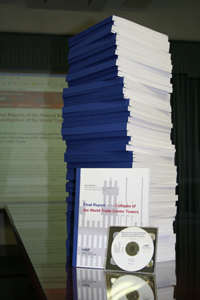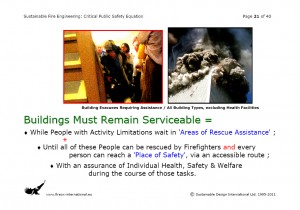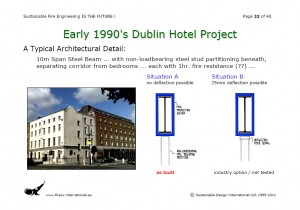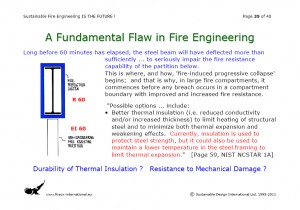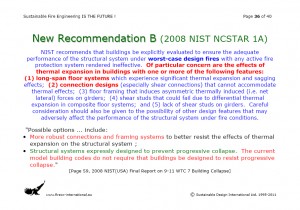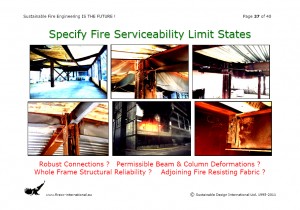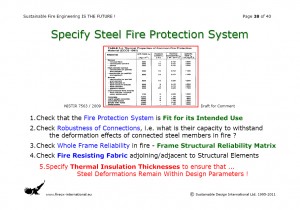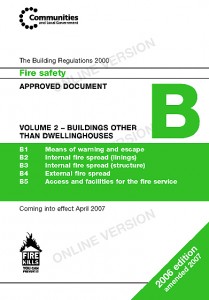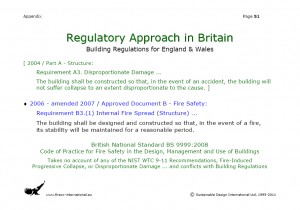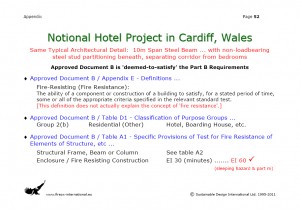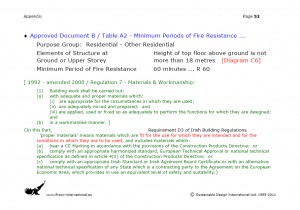Previous Posts in This Series …
2011-10-25: NIST’s Recommendations on the 9-11 WTC Building Collapses … GROUP 1. Increased Structural Integrity – Recommendations 1, 2 & 3 (out of 30)
2011-11-18: NIST WTC Recommendations 4-7 > Structural Fire Endurance … GROUP 2. Enhanced Fire Endurance of Structures – Recommendations 4, 5, 6 & 7
2011-11-24: NIST WTC Recommendations 8-11 > New Design of Structures … GROUP 3. New Methods for Fire Resisting Design of Structures – Recommendations 8, 9, 10 & 11
2011-11-25: NIST WTC Recommendations 12-15 > Improved Active Protection … GROUP 4. Improved Active Fire Protection – Recommendations 12, 13, 14 & 15
.
2011-11-30: SOME PRELIMINARY COMMENTS …
1. In the First Post of this Series, I wrote …
” As such a high level of performance is expected … indeed demanded … of a Sustainable Building … Sustainable Fire Engineering must be ‘reliability-based’ … in other words, it must have a rational, empirical and scientifically robust basis … “
Sustainable Fire Engineering must also be ‘person-centred’ … i.e. a design process (in whatever architectural or engineering discipline) which places ‘real’ people at the centre of creative endeavours and gives due consideration to their responsible needs, and their health, safety, welfare and security in the Human Environment.
In order to prolong, and if at all possible, significantly extend the Life Cycle of a Sustainable Building beyond 100 years … Fire Engineers must begin to feel at ease … and be comfortable … with the following mainstream Sustainable Design Concepts …
Flexibility: The extent to which a building interior is designed, when new, to be capable of being easily modified at any later stage during the life cycle of that building – with minimal cost and user inconvenience – because of a person’s changing living or working needs.
Adaptability: The extent to which a building, or a building component, is designed when new, or capable of being easily modified at any later stage, to meet the changing life and living needs of the broad range of potential users, who may or may not have activity limitations, or may develop a health condition during the life cycle of that building or component.
Accessibility of a Building: Ease of independent approach, entry, egress (during normal ambient conditions), evacuation (in the event of an emergency) and/or use of a building and its services and facilities, by all of the building’s potential users – with an assurance of individual health, safety and welfare during the course of those activities.
2. Group 5 of the 2005 NIST WTC Recommendations is, by far, the most important … introducing some innovative concepts of ‘real’ evacuation … with nothing too startling. Contrary to the impression given by NIST … these Recommendations are equally valid for complex building types and, in reality, for all but the most simple of low-rise buildings. It is interesting to note, however, that when discussing fire behaviour or structural performance in fire, for example … the NIST texts are confident and direct. Here, when dealing with ‘people’ issues … not so confident, prone to some rambling … and lacking clarity.
Shortly after the 2005 NIST Report (NCSTAR 1) was published, I stated the following on the SDI Corporate WebSite … at this FireOx International Page … http://www.sustainable-design.ie/fire/structdesfire.htm …
” In its treatment of ‘disability’ and ‘people with activity limitations’, the Report does not go far enough, and is seriously flawed.”
Let me explain why …
As you go scan down through NIST’s Recommendations 16-20, you will encounter 1 reference to ‘mobility impaired occupants’ and 2 references to the impersonal ‘mobility impaired’. IF (and that is still a very big ‘if’, because there is still so much rabid resistance to this topic !) … a New Post-9/11 Evacuation Model, or Construct, Dealing with ‘Disability’ is being developed … all of the major impairment groupings (i.e. visual impairment, hearing impairment, physical function impairment, mental/cognitive impairment, and psychological impairment) must be added to the mix from the beginning. In other words, our proper focus of attention must be ‘people with activity limitations’ … not just people with disabilities, but also frail older people (not all older people !), children under the age of 5 years, women in the later stages of pregnancy, people with a health condition, etc.
And … because of the social stigma still firmly attaching to ‘disability’ … many building occupants/users will not self-identify … not even if their lives depend on it !
Concentrating on one group only, i.e. people with mobility impairments, is simplistic and entirely inadequate … and we will all end up, in a few years time, having to graft on a consideration of the other impairment groups.
This is exactly what has already gone wrong with the development of Accessibility Design Guidance during the last 30 years … where ‘people with visual or hearing impairments’ received merely token attention … and ‘people with cognitive or psychological impairments’ received no attention at all ! And … we are now grappling with the challenge of having to graft on additional texts to try to re-balance International Design Guidance on Accessibility of the Built Environment. Been there – done that – I have all of the t-shirts !!
People with Activity Limitations (English) / Personnes à Performances Réduites (French): Those people, of all ages, who are unable to perform, independently and without aid, basic human activities or tasks – because of a health condition or physical/mental/cognitive/psychological impairment of a permanent or temporary nature.
The above Terms (in English and French) include …
- wheelchair users ;
- people who experience difficulty in walking, with or without a facilitation aid, e.g. stick, crutch, calliper or walking frame ;
- frail, older people ;
- the very young (people under the age of 5 years) ;
- people who suffer from arthritis, asthma, or a heart condition ;
- the visually and/or hearing impaired ;
- people who have a cognitive impairment disorder, including dementia, amnesia, brain injury, or delirium ;
- women in the later stages of pregnancy ;
- people impaired following the use of alcohol, other ‘social’ drugs e.g. cocaine and heroin, and some medicines ;
- people who suffer any partial or complete loss of language related abilities, i.e. aphasia ;
- people impaired following exposure to environmental pollution and/or other irresponsible human activities, e.g. war and terrorism ;
and …
- people who experience a panic attack in a fire situation or other emergency ;
- people, including firefighters, who suffer incapacitation as a result of exposure, during a fire, to poisonous or toxic substances, and/or elevated temperatures.
3. So … what provision should be made for ‘people with activity limitations’ in typical Fire Engineering Design Projects ?
Equivalent to the concept of Maximum Credible Fire Scenario, which has already been discussed in this Series … at FireOx International, some years ago, we developed the concept of …
Maximum Credible User Scenario
Representing building user conditions which are also severe but reasonable to anticipate …
a) 10% of People Using the Building (occupants, visitors and other users) have an Impairment (visual or hearing, physical function, mental or cognitive, psychological, with some impairments not being identifiable) ;
[ This performance indicator appears in ISO FDIS 21542: ‘Building Construction – Accessibility & Usability of the Built Environment’, which will soon be published.]
b) The Number of People Using a Building increases, on occasions which cannot be specified, to 120% of designed/calculated maximum building capacity.
[ Generally … the fire safety related texts contained in ISO 21542 are based on the 2005 & 2008 NIST WTC Recommendations.]
4. With regard to Recommendation 17 below, and NIST’s reference to the widths of evacuation staircases and door openings, etc … fire codes and regulations, fire authorities having jurisdiction (AHJ’s), and even the fire services themselves … still have a crazy mixed-up approach to defining the width of these building features … an approach which I am not even going to attempt to repeat ! Forget it !!
Without Exception … all understandings of Evacuation Route Width, Evacuation Staircase Width and Evacuation Door Opening Width … must be harmonized with the following definitions of Unobstructed Width …
Unobstructed Width – General
Free, unobstructed space – clear of all obstacles below a height of 2.1 metres above finished floor level – necessary for passage along a circulation route, or other route component, e.g. a staircase.
[ For example … the Unobstructed Width of a Staircase is the clear dimension from the edge of one handrail to the edge of the opposite handrail … and there is always a continuous handrail on each side of an evacuation staircase ! ]
Unobstructed Width – Door Opening
Free, unobstructed space – clear of all obstacles below a height of 2.0 metres above finished floor level – necessary for passage through a door opening, measured when the door leaf is opened to an angle of 90°, or when a sliding or folding door leaf is opened to its fullest extent.
[ For example … the Unobstructed Width of a Door Opening is the dimension from the edge of the door leaf (when open at an angle of 90°) to the nearest edge of the door frame.]
This FireOx International Page on the SDI Corporate WebSite provides more guidance … http://www.sustainable-design.ie/fire/appendixd.htm
5. With regard to Recommendation 20 below, and NIST’s reference to allowing “all occupants an equal opportunity for evacuation” … this is not just a ‘nice idea’, or an ‘idealistic notion’ … this is now a Human and Social Right which is backed up and supported by International Law ! And … it is no longer acceptable for the Fire Science and Engineering Community to continue its stubborn resistance in the face of this fact !!
For the benefit of my fire engineering colleagues … I will, once again here, reproduce the most relevant extracts from the United Nations Convention on the Rights of Persons with Disabilities …
UN CRPD Preamble Paragraph (g)
Emphasizing the importance of mainstreaming disability issues as an integral part of relevant strategies of sustainable development, …
UN CRPD Article 9 – Accessibility
1. To enable persons with disabilities to live independently and participate fully in all aspects of life, States Parties shall take appropriate measures to ensure to persons with disabilities access, on an equal basis with others, to the physical environment, to transportation, to information and communications, including information and communications technologies and systems, and to other facilities and services open or provided to the public, both in urban and in rural areas. These measures, which shall include the identification and elimination of obstacles and barriers to accessibility, shall apply to, inter alia:
(a) Buildings, roads, transportation and other indoor and outdoor facilities, including schools, housing, medical facilities and workplaces ;
(b) Information, communications and other services, including electronic services and emergency services.
2. States Parties shall also take appropriate measures:
(a) To develop, promulgate and monitor the implementation of minimum standards and guidelines for the accessibility of facilities and services open or provided to the public ;
(b) To ensure that private entities that offer facilities and services which are open or provided to the public take into account all aspects of accessibility for persons with disabilities ;
(c) To provide training for stakeholders on accessibility issues facing persons with disabilities ;
(d) To provide in buildings and other facilities open to the public signage in Braille and in easy to read and understand forms ;
(e) To provide forms of live assistance and intermediaries, including guides, readers and professional sign language interpreters, to facilitate accessibility to buildings and other facilities open to the public ;
(f) To promote other appropriate forms of assistance and support to persons with disabilities to ensure their access to information ;
(g) To promote access for persons with disabilities to new information and communications technologies and systems, including the Internet ;
(h) To promote the design, development, production and distribution of accessible information and communications technologies and systems at an early stage, so that these technologies and systems become accessible at minimum cost.
UN CRPD Article 11 – Situations of Risk & Humanitarian Emergencies
States Parties shall take, in accordance with their obligations under international law, including international humanitarian law and international human rights law, all necessary measures to ensure the protection and safety of persons with disabilities in situations of risk, including situations of armed conflict, humanitarian emergencies and the occurrence of natural disasters.
[ Note: An outbreak of fire in a building is a situation of serious risk for all vulnerable building occupants/users.]
.
At the time of writing, 153 Countries had signed the UN CRPD … while 106 Countries have ratified the Convention and are, therefore, the ‘State Parties’ referred to above.
These are just a few of the State Parties to the UN CRPD …
- Argentina (ratified the UN CRPD, 2008-09-02)
- Australia (ratified the UN CRPD, 2008-07-17)
- Brazil (ratified the UN CRPD, 2008-08-01)
- Canada (ratified the UN CRPD, 2010-03-11)
- China (ratified the UN CRPD, 2008-08-01)
- Cuba (ratified the UN CRPD, 2007-09-06)
- European Union (ratified the UN CRPD, 2010-12-23)
- India (ratified the UN CRPD, 2007-10-01)
- Malaysia (ratified the UN CRPD, 2010-07-19)
- Mexico (ratified the UN CRPD, 2007-12-17)
- Philippines (ratified the UN CRPD, 2008-04-15)
- South Africa (ratified the UN CRPD, 2007-11-30)
- Turkey (ratified the UN CRPD, 2009-09-28)
- United Arab Emirates (ratified the UN CRPD, 2010-03-19)
I wonder how implementation is proceeding in these countries !?!
.
2005 NIST WTC RECOMMENDATIONS
GROUP 5. Improved Building Evacuation
Building evacuation should be improved to include system designs that facilitate safe and rapid egress, methods for ensuring clear and timely emergency communications to occupants, better occupant preparedness regarding their roles and duties for evacuation during emergencies, and incorporation of appropriate egress technologies.*
[ * F-36 This effort should include standards and guidelines for the development and evaluation of emergency evacuation plans, including best practices for both partial and full evacuation, and the development of contingency plans that account for expected conditions that may require adaptation, including the compromise of all or part of an egress path before or during evacuation, or conditions such as widespread power failure, earthquake, or security threat that restrict egress from the building. Evacuation planning should include the process from initial notification of the need to evacuate up to the point when occupants arrive at a place where their safety is ensured. These standards and guidelines should be suitable for assessing the adequacy of evacuation plans submitted for approval, and should require occupant training through the conduct of regular drills.]
NIST WTC Recommendation 16.
NIST recommends that public agencies, non-profit organizations concerned with building and fire safety, and building owners and managers develop and carry out public education and training campaigns, jointly and on a nationwide scale, to improve building occupants’ preparedness for evacuation in case of building emergencies. This effort should include better training and self-preparation of occupants, an effectively implemented system of floor wardens and building safety personnel, and needed improvements to standards. Occupant preparedness should include:
a. Improved training and drills for building occupants to ensure that they know evacuation procedures for a variety of emergency scenarios (e.g. including evacuation and shelter in place), are familiar with the egress route, and are sufficiently aware of what is necessary if evacuation is required with minimal notice (e.g. footwear consistent with the distance to be travelled, a flashlight/glow stick for pathway illumination, and dust masks).
b. Building owners and managers should educate tenants on the life safety systems present in their building(s), provide training materials explaining egress routes and stairwell and elevator information, and develop educational programmes explaining the most appropriate responses in emergency situations. It is further recommended that the owners and managers of office buildings implement the necessary systems for collecting and storing the training history of each building occupant.
c. Improved training and drills that routinely inform building occupants that roof rescue is not (or is) presently feasible as a standard evacuation option, that they should evacuate down the stairs in any full-building evacuation unless explicitly instructed otherwise by on-site incident commanders, and that elevators can be used if they are still in service and haven’t been recalled or stopped.
d. Improved codes, laws, and regulations that do not restrict or impede building occupants during evacuation drills from familiarizing themselves with the detailed layout of alternative egress routes for a full building evacuation.*
[ * F-37 New York City Local Law 5 prohibits requiring occupants to practice stairwell evacuation during drills.]
Affected Standard: ICC/ANSI A117-1. Model Building and Fire Codes: The standard should be adopted in model building and fire codes by mandatory reference to, or incorporation of, the latest edition of the standard. Affected Organizations: NFPA, NIBS, NCSBCS, BOMA, and CTBUH.
NIST WTC Recommendation 17.
NIST recommends that tall buildings be designed to accommodate timely full building evacuation of occupants when required in building-specific or large-scale emergencies such as widespread power outages, major earthquakes, tornadoes, hurricanes without sufficient advance warning, fires, explosions, and terrorist attack. Building size, population, function, and iconic status should be taken into account in designing the egress system. Stairwell capacity and stair discharge door opening width* should be adequate to accommodate contraflow due to emergency access by responders.
[ * F-38 Egress capacity should be based on an all-hazards approach that considers the number and width of stairs (and door openings) as well as the possible use of scissor stairs credited as a single stair.]
a. Improved egress analysis models, design methodology, and supporting data should be developed to achieve a target evacuation performance (e.g. time for full building evacuation*) for the design building population by considering the building and egress system designs, and human factors such as occupant size, mobility status, stairwell tenability conditions, visibility, and congestion.
[ * F-39 Use of egress models is required to estimate the egress capacity for a range of different evacuation strategies, including full building evacuation. NIST found that the average surviving occupant in the WTC towers descended stairwells at about half the slowest speed previously measured for non-emergency evacuations.]
b. To the degree possible, mobility impaired occupants should be provided a means for self-evacuation in the event of a building emergency. Current strategies (and law) generally require the mobility impaired to shelter in place. New procedures, which provide redundancy in the event that the floor warden system or co-worker assistance (i.e. a buddy system) fails, should consider full building evacuation, and may include use of fire-protected and structurally hardened elevators,* motorized evacuation technology (e.g. a battery-operated evacuation chair), and/or dedicated communication technologies for the mobility impaired.
[ * F-40 Elevators should be explicitly designed to provide protection against large, but conventional, building fires. Fire-protected elevators also should be structurally hardened to withstand the range of foreseeable building-specific or large-scale emergencies. While progress has been made in developing the requirements and technologies for fire-protected elevators, similar criteria and designs for structurally hardened elevators remain to be developed.]
c. If protected/hardened elevators are provided for emergency responders but become unusable during an emergency, due to a malfunction or a conventional threat whose magnitude exceeds the magnitude considered in design, sufficient stairwell capacity should be provided to ensure timely emergency responder access to buildings that are undergoing full evacuation. Such capacity could be provided either via dedicated stairways for fire service use or by building sufficient stairway capacity (i.e. number and width of stairways and/or use of scissor stairs credited as a single stair) to accommodate the evacuation of building occupants while allowing access to emergency responders with minimal hindrance from occupant contraflow.
d. The egress allowance in assembly use spaces should be limited in state and local laws and regulations to no more than a doubling of the stairway capacity for the provision of a horizontal exit on a floor, as is the case now in the national model codes.* The use of a horizontal exit creates an area of refuge with a 2 hour fire rated separation, at least one stair on each side, and sufficient space for the expected occupant load.
[ * F-41 The New York City Building Code permits a doubling of allowed stair capacity when one area of refuge is provided on a floor, and a tripling of stair capacity for two or more areas of refuge on a floor. In the world after 11 September 2001, it is difficult to predict: (1) if, and for how long, occupants will be willing to wait in a refuge area before entering an egress stairway; and (2) what the impact would be of such a large group of people moving down the stairs on the orderly evacuation of lower floors.]
Affected Standards: NFPA 101, ASME A 17. Model Building and Fire Codes: The standards should be adopted in model building and fire codes by mandatory reference to, or incorporation of, the latest edition of the standard.
NIST WTC Recommendation 18.
NIST recommends that egress systems be designed: (1) to maximize remoteness of egress components (i.e. stairs, elevators, exits) without negatively impacting on average travel distances; (2) to maintain their functional integrity and survivability under foreseeable building-specific or large-scale emergencies; and (3) with consistent layouts, standard signage, and guidance so that systems become intuitive and obvious to building occupants during evacuations.
a. Within a safety-based design hierarchy that should be developed, highest priority should be assigned to maintain the functional integrity, survivability, and remoteness of egress components and active fire protection systems (sprinklers, standpipes, associated water supply, fire alarms, and smoke management systems). The design hierarchy should consider the many systems (e.g. stairs, elevators, active fire protection, mechanical, electrical, plumbing, and structural) and system components, as well as functional integrity, tenant access, emergency responder access, building configuration, security, and structural design.
b. The design, functional integrity, and survivability of the egress and other life safety systems (e.g. stairwell and elevator shafts, and active fire protection systems) should be enhanced by considering accidental structural loads such as those induced by overpressures (e.g. gas explosions), impacts, or major hurricanes and earthquakes, in addition to fire separation requirements. In selected buildings, structural loads due to other risks such as those due to terrorism may need to be considered. While NIST does not believe that buildings should be designed for aircraft impact, as the last line of defence for life safety, the stairwells and elevator shafts individually, or the core if these egress components are contained within the core, should have adequate structural integrity to withstand accidental structural loads and anticipated risks.
c. Stairwell remoteness requirements should be met by a physical separation of the stairwells that provide a barrier to both fire and accidental structural loads. Maximizing stairwell remoteness, without negatively impacting on average travel distances, would allow a stairwell to maintain its structural integrity independent of any other stairwell that is subject to accidental loads, even if the stairwells are located within the same structural barrier such as the core. The current ‘walking path’ measurement allows stairwells to be physically next to each other, separated only by a fire barrier. Reducing the clustering of stairways that also contain standpipe water systems provides the fire service with increased options for formulating firefighting strategies. This should not preclude the use of scissor stairs* as a means of increasing stair capacity – provided the scissor stair is only credited as a single stair.
[ * F-42 Two separate stairways within the same enclosure and separated by a fire rated partition.]
d. Egress systems should have consistent layouts with standard signage and guidance so that the systems become intuitive and obvious to all building occupants, including visitors, during evacuations. Particular consideration should be given to unexpected deviations in the stairwells (e.g. floors with transfer hallways).
Affected Standard: NFPA 101. Model Building and Fire Codes: The standard should be adopted in model building and fire codes by mandatory reference to, or incorporation of, the latest edition of the standard.
NIST WTC Recommendation 19.
NIST recommends that building owners, managers, and emergency responders develop a joint plan and take steps to ensure that accurate emergency information is communicated in a timely manner to enhance the situational awareness of building occupants and emergency responders affected by an event. This should be accomplished through better co-ordination of information among different emergency responder groups, efficient sharing of that information among building occupants and emergency responders, more robust design of emergency public address systems, improved emergency responder communication systems, and use of the Emergency Broadcast System (now known as the Integrated Public Alert and Warning System) and Community Emergency Alert Networks.
a. Situational awareness of building occupants and emergency responders in the form of information and event knowledge should be improved through better co-ordination of such information among emergency responder groups (9-1-1 dispatch, fire department or police department dispatch, emergency management dispatch, site security, and appropriate federal agencies), efficient sharing and communication of information between building occupants and emergency responders, and improved emergency responder communication systems (i.e. including effective communication within steel and reinforced concrete buildings, capacity commensurate with the scale of operations, and interoperability among different communication systems.
b. The emergency communications systems in buildings should be designed with sufficient robustness and redundancy to continue providing public address announcements or instructions in foreseeable building-specific or large-scale emergencies, including widespread power outage, major earthquakes, tornadoes, hurricanes, fires, and accidental explosions. Consideration should be given to placement of building announcement speakers in stairways in addition to other standard locations.
c. The Integrated Public Alert and Warning System (IPAWS) should be activated and used, especially during large-scale emergencies, as a means to rapidly and widely communicate information to building occupants and emergency responders to enhance their situational awareness and assist with evacuation.
d. Local jurisdictions (cities and counties or boroughs) should seriously consider establishing a Community Emergency Alert Network (CEAN), within the framework of IPAWS, and make it available to the citizens and emergency responders of their jurisdictions to enhance situational awareness in emergencies.* The network should deliver important emergency alerts, information and real time updates to all electronic communication systems or devices registered with the CEAN. These devices may include e-mail accounts, cell/mobile phones, text pagers, satellite phones, and wireless PDA’s.
[ * F-43 Types of emergency communications could include life safety information, severe weather warnings, disaster notifications (including information on terrorist attacks), directions for self-protection, locations of nearest available shelters, precautionary evacuation information, identification of available evacuation routes, and accidents or obstructions associated with roadways and utilities.]
Affected Standard: NFPA 101, and/or a new standard. Model Building and Fire Codes: The standard should be adopted in model building and fire codes by mandatory reference to, or incorporation of, the latest edition of the standard to the extent it is within the scope of building and fire codes.
NIST WTC Recommendation 20.
NIST recommends that the full range of current and next generation evacuation technologies should be evaluated for future use, including protected/hardened elevators, exterior escape devices, and stairwell descent devices, which may allow all occupants an equal opportunity for evacuation and facilitate emergency response access. Affected Standards: NFPA 101, ASME A 17, ASTM E 06, ANSI A117.1. Model Building and Fire Codes: The standards should be adopted in model building and fire codes by mandatory reference to, or incorporation of, the latest edition of the standard.
.
.
END



